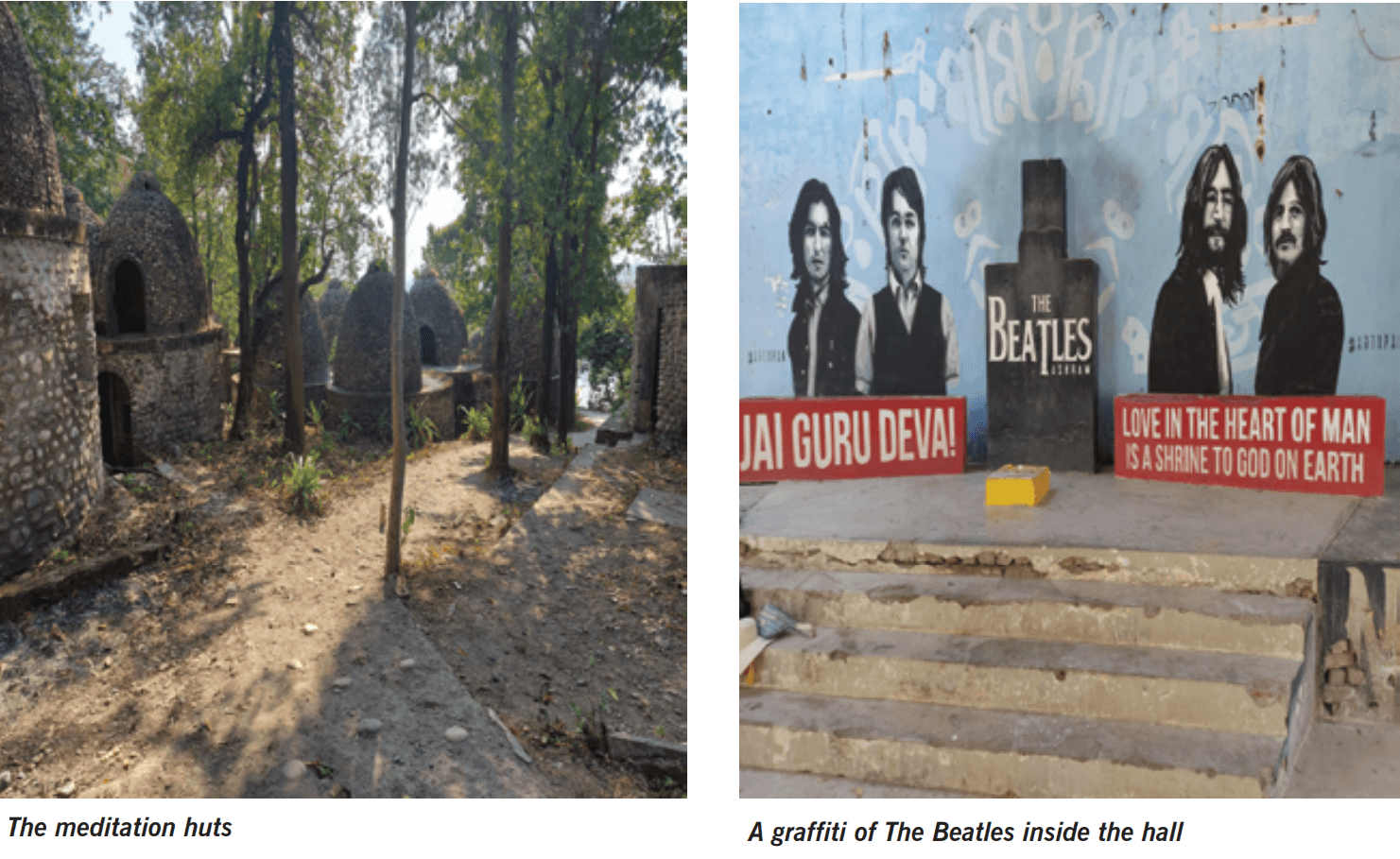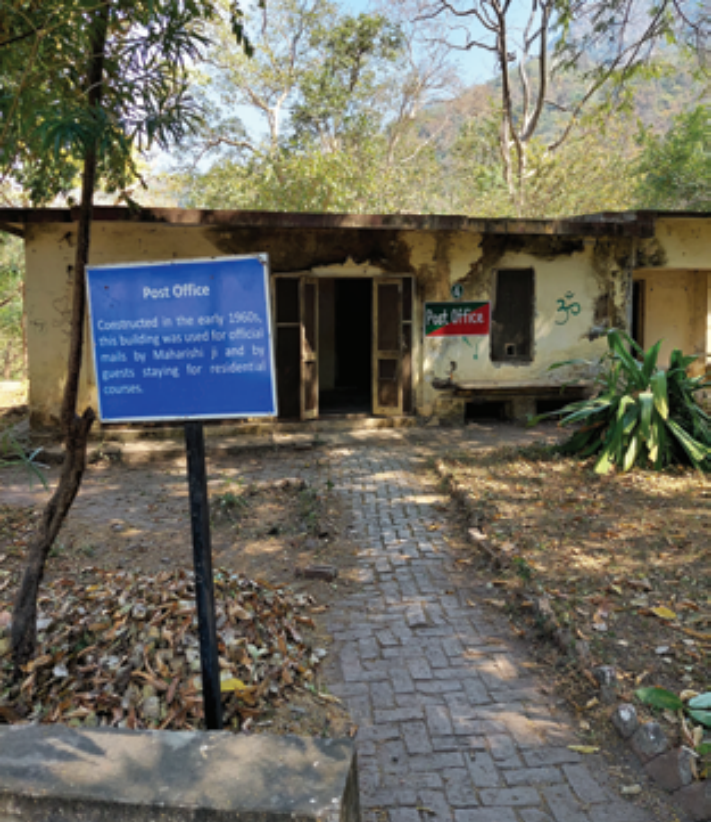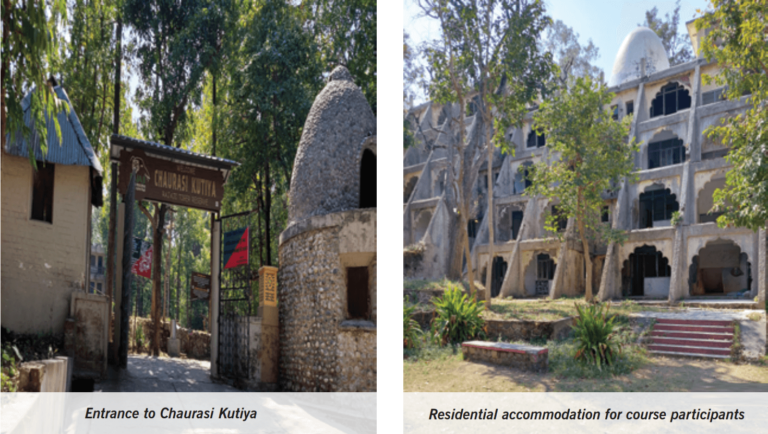Drawing its name from the species that exist on this earth, this esoteric place tucked away in the mystic climes of Rishikesh and once a favourite haunt of celebrities, was a Transcendental Meditation hub. With the legacy of Maharishi Mahesh Yogi written all over it, the complex has acquired an aura of the Beatles who made it their Ashram. Tuhina Banerjee looks at its rejuvenated avtaar.
An eerie sense of quiet and enigma swamps you as you step into Chaurasi Kutiya — the sprawling, expansive 15-acre estate tucked away in an idyllic forested area on a small hillock straddling the eastern banks of the meandering Ganga in Rishikesh. The place was once the hub of Transcendental Meditation (TM) and became the sought-after-place for celebrities – mostly from the West – in the late 1960s and 70s.
Chaurasi Kutiya (Chaurasi means 84 and Kutiya means hut) is a cluster of 84 dome-shaped huts or igloo-like enclosures built with sand, rocks and stones lugged from the holy river’s banks. Each chamber represents a different classic Yoga posture and together, they represent the whole range of human life. Vedas, the ancient Indian religious text, say there are 84 lakh species that exist on the Earth and the soul takes the form of different species based on an individual`s karma. Chaurasi Kuitya might have derived its name from this concept.
Each chamber in the hut has a sleeping area, a place for meditation, stairs that lead to a small terrace, a place to keep one’s luggage and a toilet as well.

Legacy of Maharishi Mahesh Yogi
The complex today lies unassumingly as a legacy of Maharishi Mahesh Yogi – famously known as the ‘giggling guru’ who was a student of Swami Brahmananda Saraswati — the Shankaracharya of Jyotir Math. After completing his degree in Physics in 1942, Mahesh Yogi is believed to have wandered in the Himalayas for two years after Swami Brahmananda Saraswati passed away in 1953. He led a reclusive life in Uttarkashi.
It was in 1955 that Maharishi Yogi started introducing his Transcendental Meditation (TM) to India and the world. He began his first global tour in 1958, and imparted training to more than 40,000 TM teachers. More than five million people were taught the TM technique and many teaching centres, colleges, universities and schools were also founded by the Yogi to teach Transcendental Meditation.
In 1959, the Honolulu Star Bulletin wrote about him stating: “He has no money, he asks for nothing. His worldly possessions can be carried in one hand. Maharishi Mahesh Yogi is on a world odyssey. He carries a message that he says will rid the world of all unhappiness and discontent.”
After travelling across the globe while propagating TM, he confined himself to his room and died in his sleep on February 5, 2008 at his residence in Vlodrop in the Netherlands.
Maharishi Yogi left a legacy of meditation that is both unique and easy to practice. He made it available to all and sundry and its tailor-made accessibility made it very popular among those who wanted true inner peace.
The Beatles Ashram
Today, the Chaurasi Kutiya complex – apart from the huts – is dotted with many dilapidated and rundown structures on the verge of becoming ruins and overrun by shrubs. Chaurasi Kutiya is also known as The Beatles’ Ashram. That’s because the famed band’s Fab Four – George Harrison, John Lennon, Paul McCartney and Ringo Starr – had an eventful sojourn – a kind of spiritual retreat – here in February 1968. And it was here that the popular Liverpool band spent the most prolific phase of their career – creating a treasure-trove of 48 songs, including ‘Dear Prudence’, ‘Mother Nature’s Son’, and ‘Back in the USSR’ – which went into their iconic The White Album – in just two months or even less. A burst of creativity, indeed!
The meditation sessions – mostly TM whose source lies in the Vedas and involves a mantra tailored for each individual according to his/her requirement – offered them the much-needed solace to create and also get over the shock death of their beloved manager Brian Epstein, apparently due to an accidental drug overdose in London on August27, 1967. It was this dash of meditative energy – stimulating a relaxed and discerning state of mind and magical healing – which weaned them away from drugs and pressure of popularity while providing them a new perspective towards life and living – beyond the roaring chart success that they had achieved.
How and why they left – quite abruptly – after a brief stay is a matter for multiple conjectures, which will continue to remain so. However, one thing that will never be debated is the fact that Maharishi Yogi was a huge influencer in the illustrious band’s spiritual transformation and enlightenment and it was Chaurasi Kutiya which played a central role in the entire process of reconnecting them to their souls.
The New York Times and The Independent in their reports dwelt on the Maharishi’s influence on the Beatles, and their journey to Rishikesh to meditate, which “steered them away from LSD and inspired them to write many new songs”. (George Harrison even learned to play the sitar here). And despite all the reported fissures and confusion over their relationship, both the Beatles’ and Maharishi reconciled in the end.
Harrison said in 1977, “All Maharishi ever gave me was good advice and the technique of meditation which is really wonderful. Maharishi was fantastic and I admire him for being able in spite of all the ridicule to just keep going.” Starr said, “I feel so blessed I met the Maharishi – he gave me a mantra that no one can take away, and I still use it.” McCartney and his daughter visited Maharishi in the Netherlands in 2007 while the Yogi’s terse response to all the misunderstanding was, “I could never be upset with the angels.”
After Yogi’s death, McCartney said, “Whilst I am deeply saddened by his passing, my memories of him will only be joyful ones. He was a great man who worked tirelessly for the people of the world and the cause of unity.”
The complex as it stands today
The serenity of Chaurasi Kutiya which was reclaimed by the government in 1999 and has been part of Rajaji National Tiger Reserve since 2003 after expiry of ashram’s lease in 1981, rubs off on you. As you take a brooding walk, you encounter a number of graffiti, Pop art, pictures of Maharishi and murals of the Beatles painted by artists on the walls of abandoned buildings that used to buzz with spiritual and musical activities around 56 years ago.
Doors and windows of most of these buildings are missing. But some corners do have traces of a life lost and forgotten, which evoke a haunting feeling that you can’t simply brush off. You feel an unheard voice calling out, some unseen eyes watching you – trying to grab your attention. But nothing of this is spooky; it’s plain intriguing.
The Printing Press where Maharishi’s publications saw the light of the day, the bungalow (Saptapuri complex) where the Fab Four stayed, the post office from where the Beatles sent and received letters (postcards), Maharishi’s modest residence with a basement which is fully dark as it’s abandoned, the Dhyanpeeth, the lecture hall (Ved Bhavan) where the Maharishi addressed his disciples, the guest houses (Panchkuti) meant for international guests and dignitaries, the room where the birthday of George Harrison was celebrated, the massive kitchen which fed 500 inmates of the ashram, the huge hall where the Beatles’ meditated, composed music and chatted with friends, a three- storey building with slanting pyramidal walls with a maze of rooms – and each room with an attached balcony – where students, teachers and course participants stayed…everything seems to have frozen in an obscure time. They have a mystical touch to it and speak volumes of a vibrant, glorious time gone by.

From neglect to revival
Raju Gusain, a journalist based in Dehradun, says, “Chaurasi Kutiya came under the control of the forest department in 1999. They locked the gate of the ashram and deployed two security guards. The department adopted a casual approach initially. Taking advantage of the situation, many miscreants used to get inside and take away valuables from the complex. A lot of things (in the buildings) were vandalised and plundered. And a major chunk of the heritage was lost forever.”
On 8 December 2015, it was after much persuasion from different quarters that the Uttarakhand government opened the complex to the public. In 2016, four renowned artists were invited to produce murals. In 2018 to mark 50 years of the Beatles` visit to the place, a photo gallery showcasing their stay came up.
There are three halls. One hall showcases the essence of Transcendental Meditation and Maharishi Mahesh Yogi’s philosophy. The second hall has photos of celebrities who paid a visit to the ashram, Beatles being the cynosure, and the third hall gives you a sneak peek into the Rajaji Tiger Reserve and its inhabitants.
Gusain, who is also the India ambassador of The Beatles Story, the biggest museum of the band located in Liverpool, points out, “There are 22 rare photographs – mostly featuring those taken by two-time Emmy Award winning filmmaker Paul Saltzman – displayed here. Each photograph has a story to tell of the Beatles’ sojourn here.”
He adds, “In 2017, I had the honour of conducting a tour for The Beatles Story team to Rishikesh and Beatles Ashram. It was a memorable outing and I shared my stories with the team, who were finalising their exhibition to mark 50 years of Beatles arrival in India. I organise a heritage walk of the Chaurasi Kutiya for music lovers and Beatles fans on a regular basis.”
Gusain’s services are also availed of by the forest department. During the recent G20 summit, he guided dignitaries and took them on a tour of Chaurasi Kutiya. In 2023, the government said it was planning to develop it as an international heritage tourism destination. Saket Badola, director of Rajaji Tiger Reserve, says, “We have big plans to turn Chaurasi Kutiya into a major international tourist destination.”
Of late, there have been mounting calls to promote Chaurasi Kutiya as a world heritage site. These calls come against the backdrop of the forest department reportedly earning around Rs 1 crore a year from the visitors – the entry fee is Rs 150 for Indians and Rs 1200 for foreigners.
Vipin Sharma, managing director of– a tourist operator company – underlines, “The forest department needs to launch a major restoration plan for Chaurasi Kutiya or else a heritage, will die a slow death. It is already on the brink of a collapse, with no proper rejuvenation plan in place. The ticket price was hiked recently and now a foreign tourist has to pay Rs 1200 for entry into the ashram. This, I feel, is too high and it needs to be reduced. Raising ticket prices is not the right way to earn revenues to restore the place.”
While many say restoration could give rise to commercialisation, others believe preserving a past is crucial to saving it.


 The writer is a freelancer who specialises in lifestyle and wellness issues.
The writer is a freelancer who specialises in lifestyle and wellness issues.